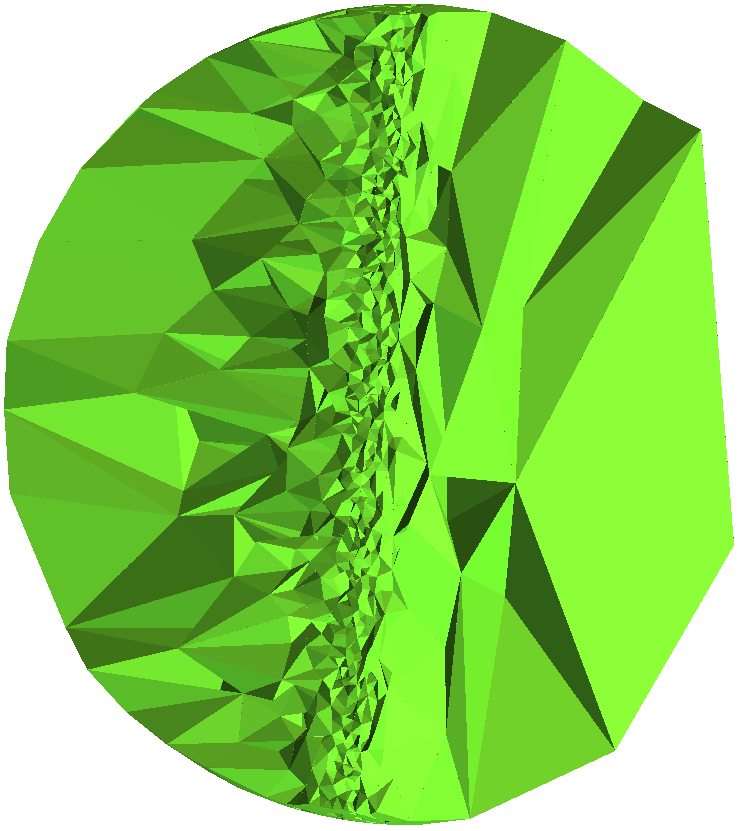Section: New Results
Mesh Generation and Geometry Processing
Isotropic 2D Quadrangle Meshing with Size and Orientation Control
Participants : Pierre Alliez, Bertrand Pellenard.
In collaboration with Jean-Marie Morvan from University of Lyon.
We propose an approach for automatically generating isotropic 2D quadrangle meshes from arbitrary domains with a fine control over sizing and orientation of the elements. At the heart of our algorithm is an optimization procedure that, from a coarse initial tiling of the 2D domain, enforces each of the desirable mesh quality criteria (size, shape, orientation, degree, regularity) one at a time, in an order designed not to undo previous enhancements. Our experiments demonstrate how well our resulting quadrangle meshes conform to a wide range of input sizing and orientation fields. [31] .
|
An Optimal Transport Approach to Robust Reconstruction and Simplification of 2D Shapes
Participants : Pierre Alliez, David Cohen-Steiner.
In collaboration with Fernando de Goes and Mathieu Desbrun from Caltech.
We propose a robust 2D shape reconstruction and simplification algorithm which takes as input a defect- laden point set with noise and outliers. We introduce an optimal-transport driven approach where the input point set, considered as a sum of Dirac measures, is approximated by a simplicial complex considered as a sum of uniform measures on 0- and 1-simplices. A fine-to-coarse scheme is devised to construct the resulting simplicial complex through greedy decimation of a Delaunay triangulation of the input point set. Our method performs well on a variety of examples ranging from line drawings to grayscale images, with or without noise, features, and boundaries. [25] .
|
Anisotropic Delaunay Mesh Generation
Participants : Jean-Daniel Boissonnat, Mariette Yvinec.
In collaboration with Camille Wormser from Google.
Anisotropic meshes are triangulations of a given domain in the plane or in higher dimensions, with elements elongated along prescribed directions. Anisotropic triangulations are known to be well suited for interpolation of functions or solving PDEs. Assuming that the anisotropic shape requirements for mesh elements are given through a metric field varying over the domain, we propose a new approach to anisotropic mesh generation, relying on the notion of anisotropic Delaunay meshes. An anisotropic Delaunay mesh is defined as a mesh in which the star of each vertex consists of simplices that are Delaunay for the metric associated to vertex . This definition works in any dimension and allows to define a simple refinement algorithm. The algorithm takes as input a domain and a metric field and provides, after completion, an anisotropic mesh whose elements are shaped according to the metric field. [46]
Triangulating Smooth Submanifolds with Light Scaffolding
Participants : Jean-Daniel Boissonnat, Arijit Ghosh.
We propose an algorithm to sample and mesh a -submanifold of positive reach embedded in [45] . The algorithm first constructs a crude sample of . It then refines the sample according to a prescribed parameter , and builds a mesh that approximates . Differently from most algorithms that have been developed for meshing surfaces of , the refinement phase does not rely on a subdivision of (such as a grid or a triangulation of the sample points) since the size of such scaffoldings depends exponentially on the ambient dimension . Instead, we only compute local stars consisting of -dimensional simplices around each sample point. By refining the sample, we can ensure that all stars become coherent leading to a -dimensional triangulated manifold . The algorithm uses only simple numerical operations. We show that the size of the sample is and that is a good triangulation of . More specifically, we show that and are isotopic, that their Hausdorff distance is and that the maximum angle between their tangent bundles is . The asymptotic complexity of the algorithm is (for fixed , and ).






